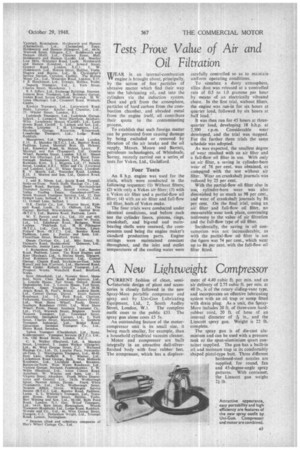Tests Prove Value of Air and
Page 37

If you've noticed an error in this article please click here to report it so we can fix it.
Oil Filtration
AR in an internal-combustion /EAR is brought about, principally, by the action of fine' particles of abrasive matter which find their way into the lubricating oil,and into the cylinders via the induction system. Dust and grit from the atmosphere, particles of hard carbon from the combustion chamber, and abraded metal from the engine itself, all contribute their quota to the contaminating process.
To establish that such foreign matter can be prevented from causing damage by being excluded or removed by filtration of the air intake and the oil supply, Messrs. Moore and Barratt, petroleum technologists, of Whiteleafe, Surrey, recently carried out a series of tests for Vokes, Ltd., Guildford. •
Four Tests
An 8 h.p. engine was used for the trials, which were conducted in the following sequence: (I) Without filters, (2) with onlya Vokes air filter; (3) with a Vokes air filter and a partial-flow oil filter; (4) with an air filter and full-flow oil filter, both.of Vokes make.
The four trials were conducted under identical conditions, and before each test the cylinder liners, pistons, rings, crankshaft, and big-end and mainbearing shells were renewed, the components used being the engine maker's standard production parts. Engine settings were maintained constant throughout, and the inlet and outlet temperatures of the cooling water were carefully controlled so as to maintain uniform operating conditions.
To simulate a dusty atmosphere, silica dust was released at a controlled rate of 0.5 to 1.0 gramme per hour by means of an electrically vibrated chute. In the first trial, without filters, the engine was run-in for six hours at quarter load, followed by six hours at half load.
It was then run for 45 hours at threequarter load, developing 18 la.h.p. at 2,500 r.p.m. Considerable wear developed, and the trial was stopped. For the further three trials the same schedule was adopted.
As was expected, the smallest degree of wear resulted with an air filter and a full-flow oil filter in use. With only an air filter, a saving in cylinder-bore wear of 76 per cent. was obtained, as commed with the test without air filter. Wear on crankshaft journals was reduced by 25 per cent.
With the partial-flow oil filter also in use, cylinder-bore wear was also diminished by as much as 98 per cent.. and wear of crankshaft journals by 86 per cent. On the final trial, using an air filter and full-flow oil filter, no measurable wear took place, convincing testimony to the value of air filtration and the full-flow type of oil filter.
Incidentally, the saving in oil consumption was not inconsiderable, as with the partial-flow oil filter in use the figure was 74 per cent., which went up to 86 per cent. with the full-flow oil filter fitted.




















































































